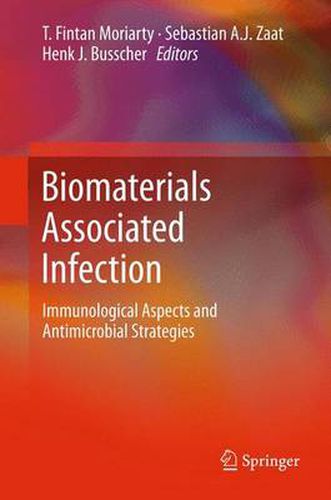Readings Newsletter
Become a Readings Member to make your shopping experience even easier.
Sign in or sign up for free!
You’re not far away from qualifying for FREE standard shipping within Australia
You’ve qualified for FREE standard shipping within Australia
The cart is loading…






This title is printed to order. This book may have been self-published. If so, we cannot guarantee the quality of the content. In the main most books will have gone through the editing process however some may not. We therefore suggest that you be aware of this before ordering this book. If in doubt check either the author or publisher’s details as we are unable to accept any returns unless they are faulty. Please contact us if you have any questions.
Biomaterials associated infection (BAI) is one of the most common complications associated with implantation of any biomaterial regardless of form or function. These infections usually involve bacterial colonization and biofilm formation on the biomaterial itself, rendering the infection impervious to antimicrobials and host defenses. In addition, it is becoming increasingly clear that infection of the surrounding tissues also plays an important role in BAI, and that the infection may be influenced by the composition and design of the implanted biomaterial. In this book, worldwide leaders in the field address this critical problem in the translation of biomaterials research into clinical practice. The book begins with an emphasis on the latest research in the pathogenesis of BAI from microbiological, immunological, and materials science perspectives. The current state of the art in antimicrobial activation of biomaterials through surface modification and the incorporation of antimicrobial agents is then discussed. In the concluding chapters, successful translation of a selection of antimicrobial technologies from preclinical research into clinical use is described alongside a discussion of the utility of these devices and perspectives for future development. This book is essential reading for researchers and clinicians who are interested in understanding the fundamentals of BAI, the latest in antimicrobial materials research, and the state of the art in clinically available antimicrobial containing medical devices.
$9.00 standard shipping within Australia
FREE standard shipping within Australia for orders over $100.00
Express & International shipping calculated at checkout
This title is printed to order. This book may have been self-published. If so, we cannot guarantee the quality of the content. In the main most books will have gone through the editing process however some may not. We therefore suggest that you be aware of this before ordering this book. If in doubt check either the author or publisher’s details as we are unable to accept any returns unless they are faulty. Please contact us if you have any questions.
Biomaterials associated infection (BAI) is one of the most common complications associated with implantation of any biomaterial regardless of form or function. These infections usually involve bacterial colonization and biofilm formation on the biomaterial itself, rendering the infection impervious to antimicrobials and host defenses. In addition, it is becoming increasingly clear that infection of the surrounding tissues also plays an important role in BAI, and that the infection may be influenced by the composition and design of the implanted biomaterial. In this book, worldwide leaders in the field address this critical problem in the translation of biomaterials research into clinical practice. The book begins with an emphasis on the latest research in the pathogenesis of BAI from microbiological, immunological, and materials science perspectives. The current state of the art in antimicrobial activation of biomaterials through surface modification and the incorporation of antimicrobial agents is then discussed. In the concluding chapters, successful translation of a selection of antimicrobial technologies from preclinical research into clinical use is described alongside a discussion of the utility of these devices and perspectives for future development. This book is essential reading for researchers and clinicians who are interested in understanding the fundamentals of BAI, the latest in antimicrobial materials research, and the state of the art in clinically available antimicrobial containing medical devices.